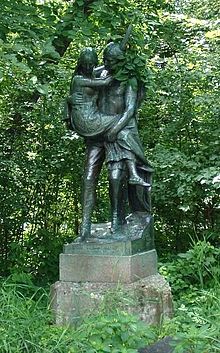The song of Hiawatha
The Song of Hiawatha (in the English original The Song of Hiawatha ) is a long poem in the form of an epic , written by Henry Wadsworth Longfellow (1807-1882). It tells of the life of the Indian Hiawatha , who lived in the 16th century.
After an introduction, 22 sections describe Hiawatha's life from his childhood through his marriage to Minnehaha to his death. Longfellow also interwoven other legends of the Indians.
The introduction of further legends, but also the metrics of the work, are reminiscent of the Finnish national epic Kalevala . It is entirely possible that Longfellow had learned some Finnish a few years before he wrote his poem, but later had access to a translation of the Finnish work.
This seal Longfellow's Symphony From the New World by Antonin Dvorak been processed musically.
In 1900 the English composer Samuel Coleridge-Taylor set three scenes to music , namely Hiawatha's wedding, the death of Minnehaha and Hiawatha's departure in three cantatas for orchestra , choir and soloists .
Walt Disney adapted the character in 1937 for the Silly Symphonies in the cartoon Little Hiawatha , known in Germany as Klein Adlerauge. A comic series of the same name appeared at irregular intervals in the Mickey Mouse series.
In 1972 the composer duo Chinn / Chapman Hiawatha incorporated into the glam rock song Wig-Wam Bam by the English group Sweet . Even Mike Oldfield used 1,978 parts from the Hiawatha poem for his album Incantations .
Web links
- Original text in English
- German translation
- Klein Adlerauge ( Memento from December 20, 2003 in the Internet Archive )
